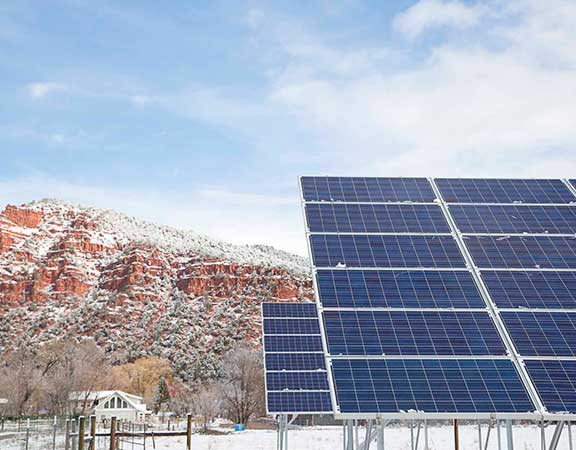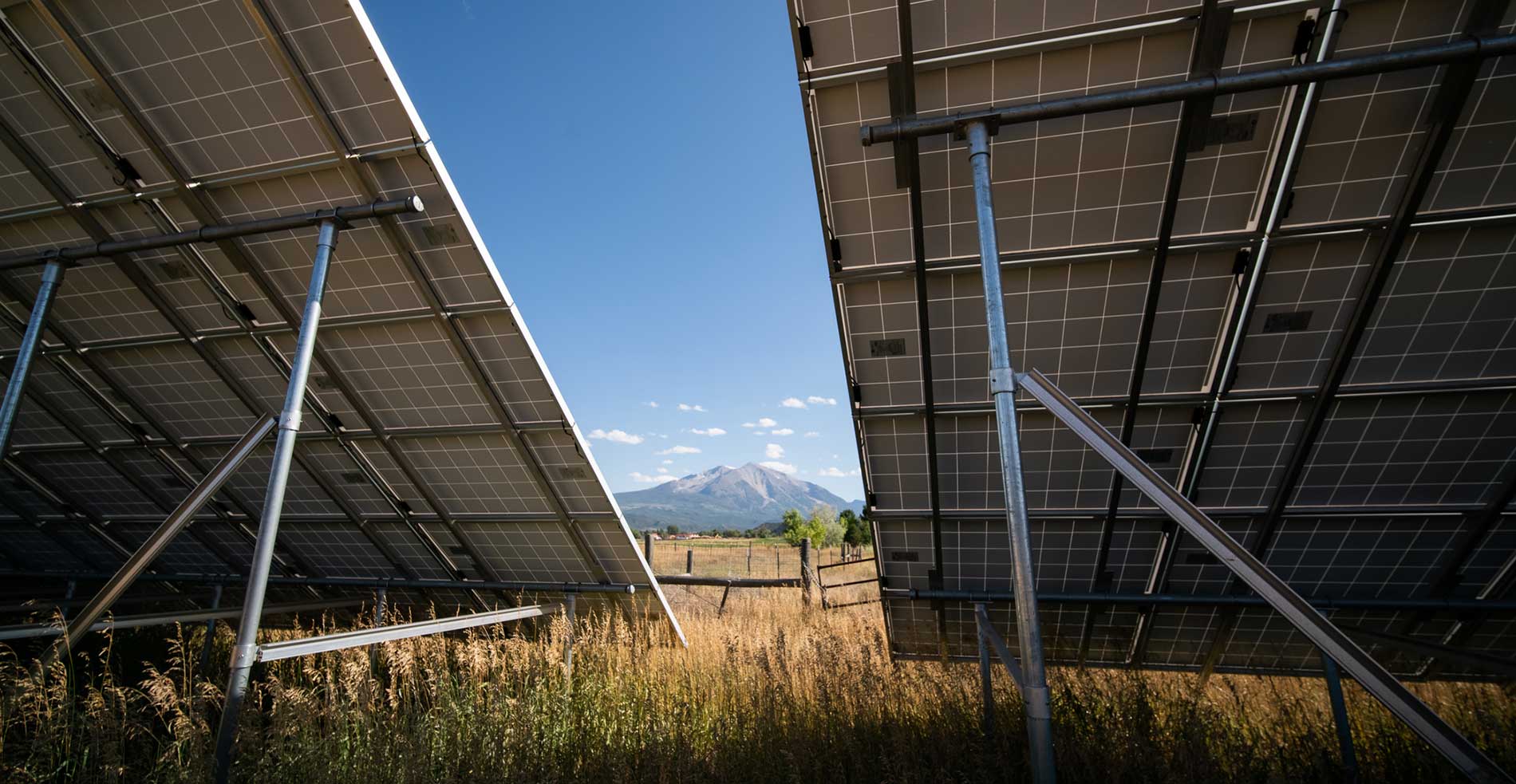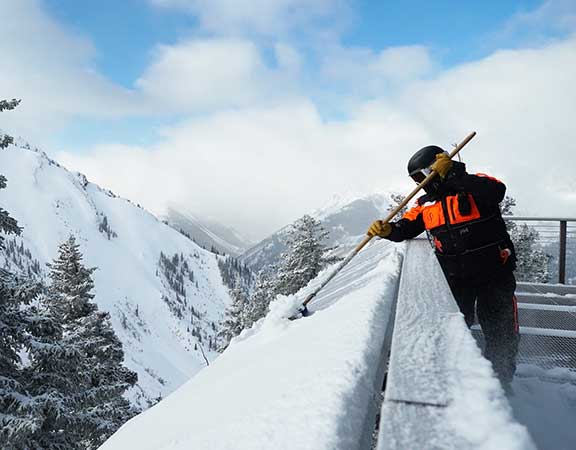We didn’t do these projects because they were slam dunks or made us money, we did them because we were trying to support a nascent industry and model possibility for others." – Auden Schendler, Senior VP of Sustainability at Aspen Skiing Company
The Power Of The Sun

Whether or not you buy the oft-touted claim that Colorado gets 300 days of sunshine per year, the fact is we get plenty of it in Aspen Snowmass. That makes for a lot of fun in the sun, but also underpins a growing clean-energy industry. With robust state tax incentives and favorable net-metering laws, solar power projects are not only viable, but desirable in our neck of the woods.
Aspen Skiing Company (ASC) has been at the forefront of harnessing solar energy since 2004, when it installed the first solar array in the ski industry at Aspen Highlands ski patrol headquarters. Framed by the famous Maroon Bells, the 2.3-kilowatt array off the patrol building deck has made for plenty of photo ops and conversation starters — but this installation, as groundbreaking as it might have been for the industry 15 years ago, still only powers about a third of the building’s overall energy consumption.
Still, it was a good project to warm up with, so to speak. ASC knew it had to go bigger to make a real impact. In 2007, they installed a solar array four times the size of the Highlands one, 10.6-kilowatts, on the Thunder River Lodge, an ASC employee-housing complex in Carbondale. It powers about one-third of the 23-unit building’s electricity use, and more importantly, keeps 27,000 pounds of carbon dioxide out of the air each year.
Aspen Skiing Company (ASC) has been at the forefront of harnessing solar energy since 2004, when it installed the first solar array in the ski industry at Aspen Highlands ski patrol headquarters. Framed by the famous Maroon Bells, the 2.3-kilowatt array off the patrol building deck has made for plenty of photo ops and conversation starters — but this installation, as groundbreaking as it might have been for the industry 15 years ago, still only powers about a third of the building’s overall energy consumption.
Still, it was a good project to warm up with, so to speak. ASC knew it had to go bigger to make a real impact. In 2007, they installed a solar array four times the size of the Highlands one, 10.6-kilowatts, on the Thunder River Lodge, an ASC employee-housing complex in Carbondale. It powers about one-third of the 23-unit building’s electricity use, and more importantly, keeps 27,000 pounds of carbon dioxide out of the air each year.

The next year, ASC’s role in solar energy leadership solidified when it financed and built a 147-kilowatt solar array at the Colorado Rocky Mountain School campus in Carbondale. The school and its public partner, the Town of Carbondale (where the idea had originated as a way to expand its renewable energy portfolio), needed a private-sector partner to invest in the $1.1 million project and to be able to take advantage of the tax benefits. The company would own and operate the array — then the largest on the Western Slope — for 20 years, selling enough power to CRMS and to electric utility Xcel Energy for 20 average American homes to use in a year.
“We didn’t do these projects because they were slam dunks or made us money, we did them because we were trying to support a nascent industry and model possibility for others,” says Auden Schendler, ASC senior vice president of sustainability.
Also in 2008, ASC installed a 5-kilowatt array on the roof of the Little Nell Hotel, the panels entirely powering the 2,500-square-foot Paepcke Suite. The project also included small arrays at the Aspen Mountain Sundeck and at the Snowmass Club, when it was owned by the company.
Also in 2008, ASC installed a 5-kilowatt array on the roof of the Little Nell Hotel, the panels entirely powering the 2,500-square-foot Paepcke Suite. The project also included small arrays at the Aspen Mountain Sundeck and at the Snowmass Club, when it was owned by the company.
Sensible About Solar

Mount Sopris in summer framed by solar panels
While none of these came close to covering the large amount of energy ASC requires, the projects built on themselves, and officials learned along the way. While the solar projects are a start, and a decent offset in some operations, the company realized that the only way to put a real dent in the climate problem was at a much higher level: to create systematic change. So, the company got more involved in policy and lobbying for sustainable energy. That knowledge and credibility has in turn helped nudge Holy Cross Energy, another regional electricity provider, into escalating its renewable power generation. The utility is now on track to providing 100 percent green energy by 2030 — a milestone that will cut ASC’s carbon footprint in half from 2000 levels.
“Solar exemplifies how our sustainability strategy evolved over the years in terms of going from greening our operations in small ways, to building larger projects, to working at scale and policy level,” says Hannah Berman, Sustainability and Philanthropy Manager for ASC.
“Solar exemplifies how our sustainability strategy evolved over the years in terms of going from greening our operations in small ways, to building larger projects, to working at scale and policy level,” says Hannah Berman, Sustainability and Philanthropy Manager for ASC.

Fast forward to 2021, when two more solar projects are joining the company’s green energy portfolio. On the roof of the Village Express lift terminal in Snowmass Base Village, solar panels repurposed from the Sundeck are producing electricity equal to one-quarter of what an average US home uses per year. The array more than offsets a snow-melt system put into a dangerously icy sidewalk approaching The Treehouse — a project which the company could have mitigated by simply paying $5,000 into the town’s offset program rather than taking the time to repurpose the old Sundeck panels.
A drive to make a real-world difference is also behind ASC’s first completely electric building. Nearly one-third powered by an 86-kilowatt solar array, the 53,000-square-foot building in Willits includes 43 apartments for the company’s workforce. The Willits system will produce as much electricity as 12 homes use annually.
“Electrification is the movement in the green-building world,” says Ryland French, Director of Facility Operations and Energy at ASC. “Electricity can be powered partially by renewables now, and eventually entirely by renewables in the future; whereas a building heated with natural gas is locked into fossil fuels for decades.”
“Electrification is the movement in the green-building world,” says Ryland French, Director of Facility Operations and Energy at ASC. “Electricity can be powered partially by renewables now, and eventually entirely by renewables in the future; whereas a building heated with natural gas is locked into fossil fuels for decades.”
About The Author

CATHERINE LUTZ
Catherine Lutz is an Aspen-based freelance writer and editor who has helped craft stories and content for the Aspen Institute, Aspen Sojourner magazine, Powder magazine, and many others. An avid skier, paddleboarder, and mountain biker, she’s now vicariously experiencing a second childhood through her two young children in one of the best places on the planet to raise a family.You Might Also Like

3 Ways Our Tech Makes Your Ski Day Easier
